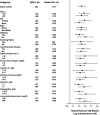Protein Carbamylation and the Risk of ESKD in Patients with CKD
- PMID: 36757153
- PMCID: PMC10125635
- DOI: 10.1681/ASN.0000000000000078
Protein Carbamylation and the Risk of ESKD in Patients with CKD
Abstract
Significance statement: Protein carbamylation, a nonenzymatic post-translational protein modification partially driven by elevated blood urea levels, associates with mortality and adverse outcomes in patients with ESKD on dialysis. However, little is known about carbamylation's relationship to clinical outcomes in the much larger population of patients with earlier stages of CKD. In this prospective observational cohort study of 3111 individuals with CKD stages 2-4, higher levels of carbamylated albumin (a marker of protein carbamylation burden) were associated with a greater risk of developing ESKD and other significant adverse clinical outcomes. These findings indicate that protein carbamylation is an independent risk factor for CKD progression. They suggest that further study of therapeutic interventions to prevent or reduce carbamylation is warranted.
Background: Protein carbamylation, a post-translational protein modification partially driven by elevated blood urea levels, associates with adverse outcomes in ESKD. However, little is known about protein carbamylation's relationship to clinical outcomes in the much larger population of patients with earlier stages of CKD.
Methods: To test associations between protein carbamylation and the primary outcome of progression to ESKD, we measured baseline serum carbamylated albumin (C-Alb) in 3111 patients with CKD stages 2-4 enrolled in the prospective observational Chronic Renal Insufficiency Cohort study.
Results: The mean age of study participants was 59 years (SD 10.8); 1358 (43.7%) were female, and 1334 (42.9%) were White. The mean eGFR at the time of C-Alb assessment was 41.8 (16.4) ml/minute per 1.73 m 2 , and the median C-Alb value was 7.8 mmol/mol (interquartile range, 5.8-10.7). During an average of 7.9 (4.1) years of follow-up, 981 (31.5%) individuals developed ESKD. In multivariable adjusted Cox models, higher C-Alb (continuous or quartiles) independently associated with an increased risk of ESKD. For example, compared with quartile 1 (C-Alb ≤5.80 mmol/mol), those in quartile 4 (C-Alb >10.71 mmol/mol) had a greater risk for ESKD (adjusted hazard ratio, 2.29; 95% confidence interval, 1.75 to 2.99), and the ESKD incidence rate per 1000 patient-years increased from 15.7 to 88.5 from quartile 1 to quartile 4. The results remained significant across numerous subgroup analyses, when treating death as a competing event, and using different assessments of eGFR.
Conclusions: Having a higher level of protein carbamylation as measured by circulating C-Alb is an independent risk factor for ESKD in individuals with CKD stages 2-4.
Podcast: This article contains a podcast at https://dts.podtrac.com/redirect.mp3/www.asn-online.org/media/podcast/JASN/2023_04_24_JSN_URE_EP22_042423.mp3.
Copyright © 2023 by the American Society of Nephrology.
Figures


Comment in
-
Carbamylation in Uremia.J Am Soc Nephrol. 2023 May 1;34(5):731-732. doi: 10.1681/ASN.0000000000000106. Epub 2023 Apr 5. J Am Soc Nephrol. 2023. PMID: 37022135 Free PMC article.
References
-
- United States Renal Data System. USRDS Annual Data Report: Epidemiology of Kidney Disease in the United States. National Institutes of Health, National Institute of Diabetes and Digestive and Kidney Diseases; 2020.
Publication types
MeSH terms
Substances
Grants and funding
LinkOut - more resources
Full Text Sources
Medical
Research Materials
Miscellaneous

